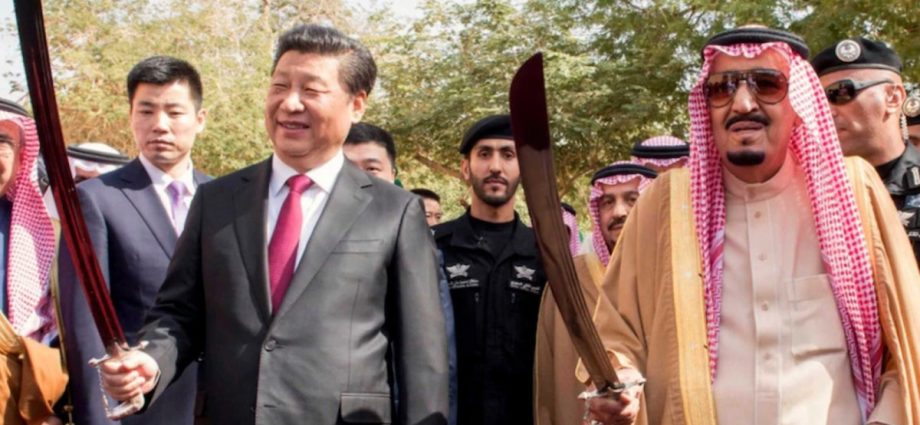
If evidence were needed of just how rapidly economic ties are growing between China and Saudi Arabia, you only have to look at two events that took place last month.
The first was the China-Arab Business Conference in Riyadh. More than 30 agreements worth at least US$10 billion were reached during the gathering.
The second was the World Economic Forum event held last week in the Chinese city of Tianjin, known as the “Summer Davos.” The level of importance Saudi Arabia placed on the event was reflected by the unprecedented number of senior-level figures attending.
The kingdom sent a delegation of 24 officials, including the economy and planning minister and the communications and information technology minister. While no major deals were announced, it was clear that both countries wanted to use the event to explore deep economic cooperation.
For decades, economic ties between China and Saudi Arabia focused on the kingdom’s crude-oil exports. However, in recent years, the relationship has rapidly diversified, reflecting a desire by both countries to advance economic relations beyond the traditional focus on energy resources.
For China, the approach has gone from being purely transactional to far more multifaceted and intertwined in the economic and political futures of Saudi Arabia and other countries in the region.
Consistent commitment
The Chinese buy-in acts as the most convincing guarantee for regional powers of Beijing’s commitment to engage and stay in the region. This is in stark contrast to the perceived lack of commitment by the United States and presents an enormous challenge to Washington’s efforts to maintain its influence in the Middle East.
Economic ties between Beijing and Riyadh were already strong. Saudi Arabia has for years been the largest exporter of crude oil to China. The kingdom has also been Beijing’s largest trading partner in the Middle East for more than two decades. In comparison, China has been Saudi Arabia’s largest trading partner since 2013.
The clearest milestone that the relationship was transitioning to something deeper came during President Xi Jinping’s visit to Saudi Arabia last December. The two governments identified a broad spectrum of future cooperation, including on energy, cars, supply chains, communications, transportation, mining, and the financial sector.
Beijing and Riyadh have striven to find overlap between China’s Belt and Road Initiative and Saudi Arabia’s Vision 2030 reform program, leading to cooperation on new energy resources including solar, wind and hydropower, and on digital economy, such as a fifth-generation (5G) telecom network.
These areas of cooperation were again on display during the China-Arab Business Conference last month. A $5.6 billion agreement signed between the Saudi Investment Ministry and Chinese carmaker Human Horizon will focus on developing and manufacturing electric vehicles.
As well, a $500 million deal between Saudi ASK Group and China National Geological & Mining Corporation will enable the Chinese company to develop copper mines in the kingdom.
Another field for future cooperation is tourism, which has been referred to as the “new oil” of Saudi Arabia. Since easing restrictions for visitors, the kingdom views tourism as a key area for economic growth and has vowed to invest more than $800 million in its development. During the China-Arab Business Conference, 26 agreements were signed between Saudi Arabia and Chinese travel agencies.
Broad range of business interests
The range and scale of the dealmaking point to an evolution from China’s merely transactional relationship with Middle Eastern countries.
Previously, what China wanted from the region – energy resources – could be acquired through commercial trade, without the need for long-term strategic investment. The transactional nature of the relationships meant China could maintain good relations with often opposing camps and actors in the region. The approach may have given Beijing flexibility, but it was criticized for lacking strategic engagement or long-term vision.
In the past decade, China’s strategy has become more mindful and intentional. The diversification of economic ties with Saudi Arabia is one such example.
Beijing is no longer content with being just a main customer of the region’s crude oil. Instead, it wants to maximize the region’s potential as a market for Chinese goods, labor and technologies; and embed itself in the economic futures of the countries in the region through investment and long-term collaboration.
Instead of being purely transactional, China is developing a regional strategy that combines shared visions on domestic governance and connected economic future.
This commitment has effectively boosted China’s credibility in the region as an economic partner and as a diplomatic player. This is in stark contrast to the constant questioning about whether the US is fully committed to the region and Washington’s shifting geopolitical focus.
Beijing’s economic buy-in, consistent investment and bilateral relationships are perhaps the most effective instruments in its competition with the US for influence in the region.
The challenge for Washington is tremendous. With a conscious strategy by Beijing to deepen Middle East ties, it will be even more difficult for the US to juggle among its different geopolitical priorities, which include Ukraine, the Indo-Pacific region and China.
Beijing does not need to achieve the maximum within its capacity. It only needs to show it is doing more and better than the US to gain the hearts and minds of the leaders in the region.
China’s deepening strategic engagement also offers Middle Eastern countries more room for maneuver and more bargaining power with the US. The availability of options and alternatives is always a powerful reminder for Washington that the region does not have to follow American principles and guidelines.
In the meantime, Saudi Arabia’s deepening and diversifying economic ties with Beijing will continue.
This article was provided by Syndication Bureau, which holds copyright.
Yun Sun is director of the China program and co-director of the East Asia program at the Stimson Center in Washington.

